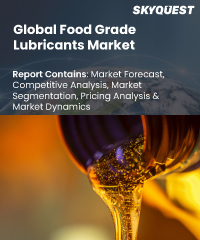
Report ID: SQMIG15A2122

Report ID:
SQMIG15A2122 |
Region:
Global |
Published Date: July, 2024
Pages:
184
|
Tables:
99 |
Figures:
77
Food Grade Lubricants Market size was valued at USD 390 Million in 2023 and is poised to grow from USD 423.8 Million in 2024 to USD 813.9 Million by 2032, growing at a CAGR of 0.085 during the forecast period (2025-2032).
The increasing consumption of processed foods and beverages is anticipated to be the main factor driving the demand for food-grade lubricants. The demand for lubricants from end-use sectors including food, beverage, pharmaceuticals, cosmetics, and others is likely to increase throughout the projected period. Also, it is anticipated that consumption of items like dairy, meat, and beverages will increase throughout the forecast period.
The integrated lubricant producers, which provide a consistent supply of raw materials to make the additives and mineral oils required for the production of lubricants, include significant oil and gas firms like British Petroleum, Total SA, and Exxon Mobil Corporation. Yet, other lubricant producers have binding agreements with both suppliers and producers of raw materials. With the help of this tactic, these businesses are able to minimize the effects of price changes and time wastage when acquiring these goods.
In several industries, such as the food and automotive industries, bio-based lubricants have come to be recognized as an alternative to conventional petroleum-based products. They come from either vegetable or animal fats. Natural oils undergo esterification, transesterification, and oxidation chemical modifications to create enhanced bio-lubricants. Compared to mineral oils, natural oils are more readily available, less expensive, and have superior biodegradability. Sunflower, canola, soybean, and rapeseed oil high oleic variations are currently the norm for base oils in biodegradable greases.
The market for bio-based lubricating goods is expanding quickly. Due to strict environmental protection laws and growing consumer awareness in the region, North America and Europe have become the biggest users of these items. On the other hand, Asia Pacific dominates the market for synthetic lubricants while trailing in the bio-lubricants sector. The regulatory frameworks in the Asia-Pacific area have begun to resemble those in the United States and Europe, and nations like Japan and South Korea are placing a great focus on eco-friendly lubricants.
US Food Grade Lubricants Market is poised to grow at a sustainable CAGR for the next forecast year.
Our industry expert will work with you to provide you with customized data in a short amount of time.
REQUEST FREE CUSTOMIZATIONWant to customize this report? This report can be personalized according to your needs. Our analysts and industry experts will work directly with you to understand your requirements and provide you with customized data in a short amount of time. We offer $1000 worth of FREE customization at the time of purchase.

Report ID: SQMIG15A2122